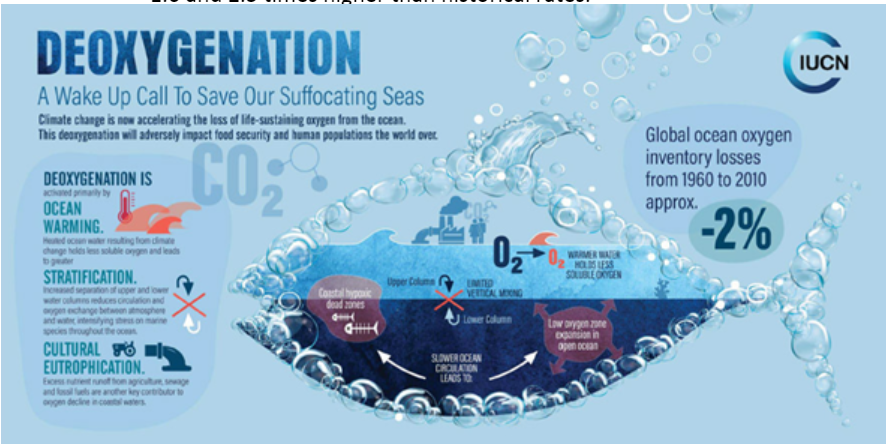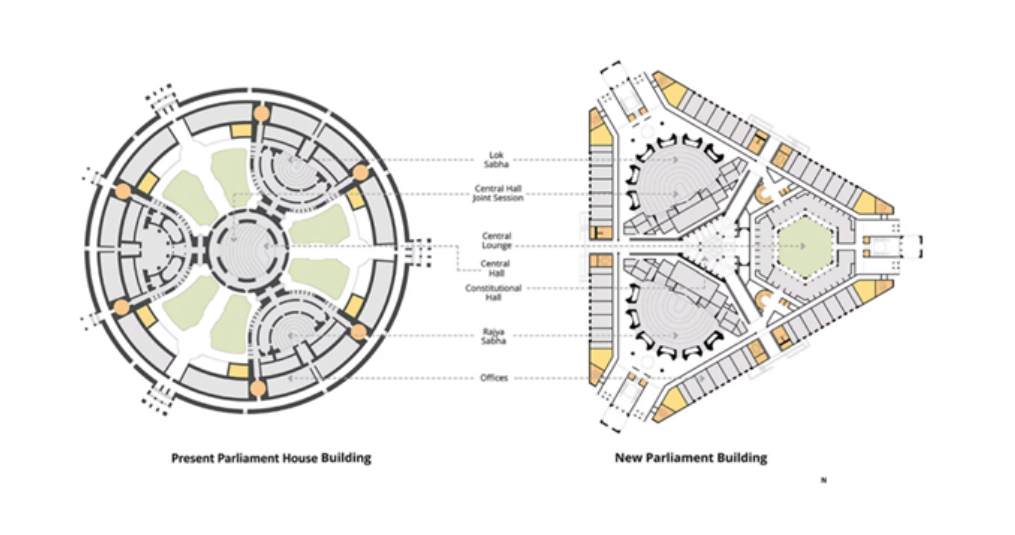Friday, 22nd September 2023
Nari Shakti Vandan Adhiniyam 2023/ Women Reservation Bill
In News: Women Reservation Bill aka Nari Shakti Vandan Adhiniyam 2023 was passed in both Lok Sabha and Rajya Sabha with almost unanimous support (2 dissents in Lok Sabha).
About Nari Shakti Vandan Adhiniyam 2023
- The 128th Constitution Amendment Bill, was introduced in Lok Sabha and passed with more than two-thirds majority. The Rajya Sabha witnessed the unopposed passage of the bill.
- Now half of the state legislatures need to ratify the bill with a simple majority to enact the bill after the president's approval.
- Key Provisions of the bill are:
- Reservation Percentage and sub-categorization: It provides reservations to one-third of all seats for women in the Lok Sabha, the state legislative assemblies and the Legislative Assembly of the NCT. The reservation will also extend to the seats reserved for SCs and STs in Lok Sabha and state legislative assemblies.
- Commencement of reservation: The reservation will be effective once the census conducted after the commencement of this Bill has been published. Based on the census, delimitation will be undertaken to reserve seats for women.
- Duration of reservation: Reservation provided for a period of 15 years. However, it shall continue till such date as determined by a law made by Parliament.
- Rotation of Seats: Seats reserved will be rotated after each delimitation, as determined by a law made by Parliament
- Amendments in the articles of Constitution:
- Article 330A and 332A inserted for one third reservation in Lok Sabha and State Assemblies respectively.
- Article 330A inserts a clause for reserving one third of seats for women within SC and ST category seats of Lok Sabha.
- Article 239AA inserts a subsection reserving seats for women in the legislative assembly of NCT of Delhi.
History of Women Reservation Bill:
- National Movement: The demand for political reservation of women was first raised during the freedom struggle, when three women bodies sent a letter to the British Prime Minister in 1931 seeking political reservation for women.
- Constituent Assembly Debates: The issue of women reservation also came up in Constituent Assembly debates. But it was rejected saying that democracy is expected to give representation to all groups.
- Committee of the Status of Women 1971: The committee recommended the reservation of women in local bodies.
- The National Perspective Plan for Women in 1988: This plan also recommended the reservation of women in local bodies. Consequently, 73rd and 74th Constitutional amendments, mandated all State governments to reserve one-third of the seats for women in local bodies.
- Efforts by different political Parties: The Women Reservation Bill was first introduced in 1996 as 81st Constitutional Amendment Bill. However the bill got lapsed. Later it was reintroduced in 2003, 20004 and 2010 but could not be passed due to several objections.
Arguments in the Favour of the enactment of Women Reservation Bill:
- Political empowerment of women: According to the Inter-Parliamentary Union (IPU) report India ranks lower than 140 other nations in terms of women representatives in the national legislatures. Reservations would empower women and provide an increased voice of women in policy making.
- Significance of Women Leadership: Empirical evidence shows that women leaders focus on public goods related to women’s concerns. Women legislators have been associated with improved economic outcomes and infrastructure development.
- Decriminalization of politics as currently 159 MPs with charges of rape, murder, crime against women allegations in parliament. It can potentially reduce the presence of politicians with serious criminal charges.
- Breaking stereotypical role of women: With more representation of women the perceived role of women as homemakers would break and give them more respect and voice in the society.
- Breaking Patriarchy: Political representation would promote gender equality in political leadership and increase their self-worth.
Arguments against the Women reservation Bill:
- Concern of no separate OBC reservation: Bill provides reservation to SC & ST women within the existing one third reservation of seats. However OBC women constituting 60% of women population have not been provided separate reservation within the 33% reserved seats.
- Reservation in Rajya Sabha and legislative Councils: Bill does not reserve seats in Rajya Sabha and Legislative councils which are being disputed.
- Delayed Enactment of the Bill: Reservation for women in Parliament depends on the census and delimitation process. This can make actual implementation of the act politically sensitive.
- Women as proxies: Similar to the trend of Pradhan Patis, Parishad patis, etc. it is feared that MP Pati and MLA pati system could emerge where women are just proxies of their male counterparts.
- Homogeneity of Women as a group: Women are not a homogenous community like caste groups, making comparisons with caste-based reservations inappropriate.
Source: Women’s reservation Bill – finally, a House of equality | The Indian Express
Lok Sabha passes Women’s Reservation Bill with two-thirds majority
Persuasion: Green Nudge - Edukemy Current Affairs
Why in News: According to a Chinese research, awarding customers with "green points" and altering the default choice for no single-use cutlery in online food purchases resulted in a 648% rise in such orders.
Nudge Theory:
- Richard Thaler, an economist, devised the nudge theory, which underpins the idea of using minor stimuli to promote actions that are in the best interests of an individual over the long run.
- He won the Nobel Prize in economics in 2017.
- Nudge policies are gaining popularity in India as decision-makers explore for alternatives to typical command-and-control legislation to encourage constructive social and economic development.
- Nudge policies used in programs such as Swachh Bharat Mission, GiveItUp campaign and Beti Bachao Beti Padhao (BBBP), etc.
Persuasion:
- Influencing someone's views, attitudes, or actions via argument and communication is the act of persuasion.
- It entails persuading or inspiring others to embrace a specific viewpoint by presenting facts in a convincing way.
- To accomplish its goals, it frequently relies on strong communication, empathy, trustworthiness, and the application of persuasive strategies.
- To persuade people to make ecologically responsible decisions, Green Nudges employ persuasive strategies include public awareness campaigns, social norms marketing, and community-based projects.
Green Nudge:
- A Green Nudge is a subtle intervention or persuasion technique designed to influence individuals to make environmentally friendly choices without limiting their options.
- These nudges encourage eco-conscious behaviour and have been effective in addressing environmental issues by guiding people toward sustainable decisions.
- Green Nudge Examples:
- India: Zomato’s “no-cutlery” option; Government’s LiFE movement, promoting environmentally conscious living, etc.
- UK: “The Big Switch Off” campaign to save energy by encouraging people to turn off lights and appliances when not in use.
- Netherland: “Pay as you throw” policy for garbage collection, where residents pay based on the amount of waste they produce, incentivizing reduced waste generation.
- USA: San Francisco’s ban on plastic bags discourages their use and promotes reusable alternatives.
Old Pension Scheme (OPS): Red Flag by RBI
Why in News: Recently, the Reserve Bank of India (RBI) has warned that reverting to the Old Pension Scheme (OPS) from the New Pension Scheme (NPS) can be a “major step backwards” in fiscal management.
Key Points of the Observations by RBI:
- Reverting to the Old Pension Scheme (OPS) might briefly reduce state expenses, but it will surpass the New Pension Scheme (NPS) contributions by the 2030s.
- This shift could inflate the pension burden by around 4.5 times compared to NPS.
- By 2060, this additional OPS burden could reach about 1% of GDP annually for states.
- This action is seen as fiscally unsustainable and goes against the prevalent pattern of adopting defined contribution plans.
New Pension Scheme (NPS):
- Proposed by the Project OASIS report became the basis for pension reforms and what was originally conceived for unorganized sector workers, was adopted by the government for its own employees.
- The NPS was for prospective employees; it was made mandatory for all new recruits joining government service from January 1, 2004.
- The defined contribution comprised 10 percent of the basic salary and dearness allowance by the employee.
- In 2019, the government increased its contribution to 14 percent of the basic salary and dearness allowance.
- Schemes under the NPS are offered by nine pension fund managers. It is sponsored by SBI, LIC, UTI, HDFC, ICICI, Kotak Mahindra, Aditya Birla, Tata, and Max.
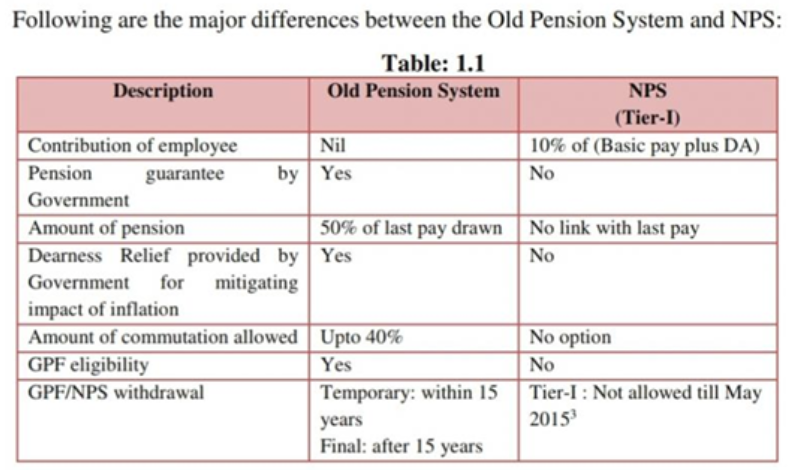 Advantages of New Pension Scheme:
Advantages of New Pension Scheme:
- NPS subscribers have complete freedom to allocate their savings to equities, corporate bonds or government securities, or any combination of the three.
- Risk-averse investors can simply allocate all their money to bonds or gilts in NPS, altogether skipping stocks.
- A review of Nifty50 over the past 20 years reveals that while it commonly provided losses during one-year intervals, extending one's holding time to 10 years lowered the loss probability to zero while earning an 11–12% return.
- Over the past ten years, NPS managers have achieved a 13–14% return on stocks and a 5–9% return on bonds and government securities, compared to the EPFO's struggle to report an 8–8.5% return on its "safe" debt portfolio.
- With NPS, an employee has greater control over his pension as he can save more or allocate more to equities.
Paryushan 2023 - Edukemy Current Affairs
In News: Recently, Paryushan Parva 2023 has been celebrated by the Jain community.
About:
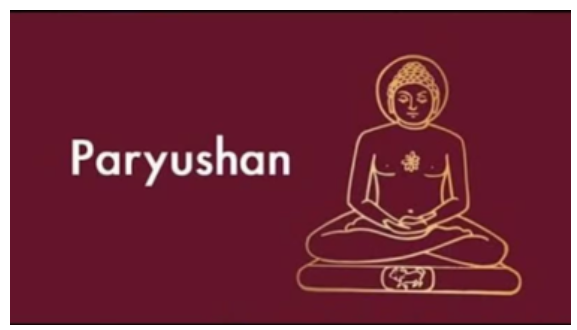
- Paryushan is one of the most important festivals of Jain community people.
- Digambar and Shwetambar both celebrate this festival with great enthusiasm and happiness.
- It takes place in the month of Bhadrapada (August or September in the Gregorian calendar) of the Jain calendar.
- The festival is believed to have originated in the 6th century BC when the Jain teacher Mahavira taught his followers to abstain from violence and to focus on spiritual purity.
- During this auspicious festival, people encourage each other to follow the path of spirituality. This festival is also known as the festival of forgiveness.
Significance:
- For both Shvetambara, who observe the ritual over eight days, and Digambars, for whom the festival lasts 10 days, this is a time for introspection, reflection, and purification.
- It is a time for spiritual growth, with fasting, meditation, and purification rituals. Devotees attend speeches, practice non-violence, and seek forgiveness for their sins.
- Five Duties of Paryushan include Samvatsari (forgiveness and reconciliation), Keshlochan (introspection and self-improvement), Pratikraman (seeking forgiveness for past wrongdoings), Penance (commitment to spiritual growth), and self-criticism and apology for past mistakes.
Hypertension - Edukemy Current Affairs
In News: Recently, the World Health Organization (WHO) released its first-ever report on the global impact of high blood pressure (hypertension), stating approximately four in every five are not treated adequately.
About:

- Blood pressure is the force exerted by circulating blood against the walls of the body’s arteries, the major blood vessels in the body.
- Hypertension is when blood pressure is too high.
- It is defined as having a systolic blood pressure level greater than or equal to 140 mmHg or diastolic blood pressure level greater than or equal to 90 mmHg or/and taking anti-hypertensive medication to lower his/her blood pressure.
Key highlights:
- The WHO report states that hypertension affects one in three adults worldwide.
- Hypertension is a significant risk factor for death and disability in India, with less than one-fourth of hypertensive patients having their blood pressure under control during 2016-2020.
- The prevalence of hypertension in India has increased, with 24% of men and 21% of women reported to have hypertension in the 2019–2020 National Family Health Survey (NFHS-5).
- The number of people living with hypertension doubled from 650 million in 1990 to 1.3 billion in 2019, with nearly half of them unaware of their condition. Over three-quarters of adults with hypertension live in low- and middle-income countries.
- The WHO recommends lifestyle changes, such as a healthier diet, tobacco cessation, and increased physical activity, as ways to lower blood pressure.
- However, if countries can expand their coverage of hypertension treatment, it could potentially avert 76 million deaths between 2023 and 2050.
Azerbaijan (Nagorno-Karabakh) - Edukemy Current Affairs
In News: Recently, Azerbaijan launched an operation against Armenian forces in Nagorno-Karabakh.
About:
Azerbaijan:
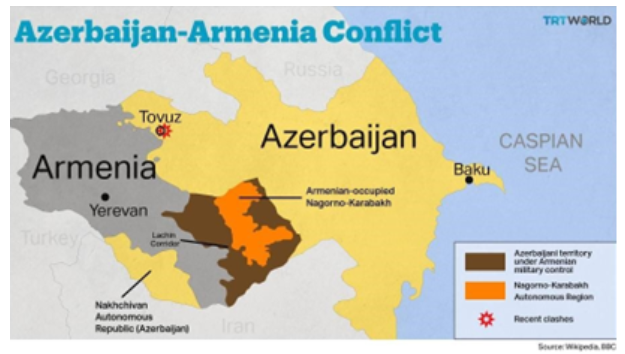
- It is a former Soviet republic nation.
- Occupying an area that fringes the southern flanks of the Caucasus Mountains, it is bounded on the north by Russia, on the east by the Caspian Sea, on the south by Iran, on the west by Armenia, and on the northwest by Georgia.
- Its capital, Baku, is famed for its medieval walled Inner City.
Nagorno-Karabakh conflict:
- Nagorno-Karabakh is a mountainous and heavily forested region that under international law is recognized as part of Azerbaijan.
- However, ethnic Armenians who constitute the vast majority of the population there reject Azeri rule (the legal system of Azerbaijan).
- A ceasefire mediated by Russia in 1994 left the region under Armenian control, though it’s still recognized as part of Azerbaijan.
- The area is now governed by separatist Armenians and called the “Nagorno-Karabakh Autonomous Oblast.”
- Strategic Significance:
- The energy-rich Azerbaijan has built several gas and oil pipelines across the Caucasus (the region between the Black Sea and the Caspian Sea) to Turkey and Europe.
- In an open war between the two countries, the pipelines could be targeted, which would impact energy supplies and may even lead to higher oil prices globally.
Phosphorus - Edukemy Current Affairs
In News: India is running out of phosphorus, which is essential for fertilizers but also a major environmental pollutant.
Reasons for Phosphorous shortage:
- Morocco and the Western Sahara region, control most of the world’s phosphorus reserves, raising geopolitical concerns.
- Coexistence of heavy metal cadmium with phosphorus in some deposits is a significant issue. Cadmium-laden fertilizers are often used in agriculture, leading to health concerns, including heart disease.
- The phosphorus shortage is due to its limited availability in geological formations and its contamination of water bodies when not properly managed.
- India is the world’s largest importer of phosphorus, primarily from cadmium-laden deposits in West Africa.
- Small portion of mined phosphorus is used in food production, with a significant amount lost to water bodies as agricultural runoff.
- Phosphorus consumed by people ends up in sewage, exacerbating environmental problems like algal blooms and fish deaths.
- To address the phosphorus scarcity, there is growing interest in mining urban sewage for high-quality phosphorus. This approach could create a sustainable source of phosphorus while mitigating environmental issues.
Collaborative Partnership on Forests
In News: Recently, the Collaborative Partnership on Forests (CPF) has issued a joint call to action looking ahead to 2030, stressing the immediate requirement for global efforts to unlock the potential of forests for the betterment of both people and the planet.
Key highlights
Significance of Forests: The CPF underscores the increasing recognition of the pivotal role forests play in attaining Sustainable Development Goals (SDGs). This involves their support for sustainable agricultural and food systems, their role in combatting climate change, reversing biodiversity decline, addressing desertification, and providing essential goods and services.
Progress and Obstacles: Swift action is essential to meet international goals and targets. This includes the imperative of expanding global forest cover by 3 percent by 2030. This expansion contributes to the preservation of carbon stocks, landscape restoration, and the creation of resilient ecosystems.
Four Key Focus Areas: The CPF outlines four primary areas of focus to tackle the challenges related to the protection, restoration, and sustainable management of forests.
- Strengthening Policies and Governance
- Enhancing Accessibility to Data and Decision-Making Tools
- Increasing Finance and Investment
- Boosting Communication and Awareness
Propelling India’s development
Exam View: Aiming for the moon; Criticism of the moonshot development strategy; Inequalities, a hurdle for progress; Reinstate state support.
Context: India must redouble efforts to make economic growth more inclusive and broad-based.
Decoding the editorial: Aiming for the moon
The momentous steps India had taken in the decades immediately after Independence may be characterised as a ‘moonshot’ approach to development deploying, modern industrialisation to shake off the ills of the past.
- Space research: When India started space research in the 1960s, many thought it was being reckless as India was sinking some of its limited resources in a highly uncertain enterprise.
- This year, India became the first nation to land a rover on the south pole of the moon, followed up with a mission to study the sun.
- Technical institutes: Between 1951 and 1961, India established five Indian Institutes of Technology, which in no time grew into globally respected academic centres.
- The first two Indian Institutes of Management were inaugurated in 1961.
- Public Sector Industries: During the two decades of the 1950s and 1960s, a number of public sector units were established in diverse areas of industrial production.
- It included steel, fertiliser, machine tools, electric machinery, drug production, and petrochemicals.
- Private enterprises: The technological capabilities built through state support provided the base for the flourishing of private enterprise in many sectors.
- Professionals, who were earlier trained in India’s public universities, have found leadership positions globally, which has deepened India’s strategic importance.
Criticism of the moonshot development strategy
- The time needed for a new technology to come to fruition is too long.
- It is not only that the benefits from a technology are long in coming, but they are also difficult to be kept exclusive for private profiteering.
- Its heavy reliance on public investment.
- It is precisely because of the ‘public good’ nature of technologies that public sector support becomes crucial for developing them.
- Even the Internet emerged from a research programme funded by the United States government, with military objectives, in the late 1950s.
- However, this investment did not waver for lack of short-term commercial viability.
- The investments being ‘misdirected’.
- Being a labour surplus country, India should have stuck to its comparative advantages in labour-intensive industries, such as garments or footwear.
Inequalities, a hurdle for progress
The lacklustre record for India’s development strategy was not on account of the government doing too much in the area of technology building. It was because the state or the government could not intervene effectively to reduce inequalities.
- Unsuccessful land reforms:
- Ownership of assets continues to be very low among the socially oppressed communities, including Dalits or the Scheduled Caste (SC) population.
- Lack of access to education:
- The lack of assets translate into hurdles in acquiring education, given that India has consistently underinvested in basic education for the masses.
- Unequal labour market:

-
- The historically determined inequalities in the social spheres get replicated in the labour market.
- In 2021-22, 38.2% of all SC workers were ‘casual’, earning their livelihoods mostly out of hard manual labour; the corresponding proportion was 11.2% for workers belonging to the (‘other’) general category castes (Periodic Labour Force Survey data).
- Lopsided industrial and economic growth:
- Domestic demand comes largely from the upper income classes, who constitute only a small, though substantial in absolute numbers, segment of the population.
- This has slowed down the growth of manufacturing of high-quality, mass-consumption goods, including food products and garments.
- Entrepreneurship too has emerged from a narrow social base.
Reinstate state support
- India must reinstate technological efforts to stand a chance in fast-growing economic fields, be it semiconductors or biotechnology.
- India must reinstate support for its industries.
- After 1991, India abandoned planning for industrial growth assuming, mistakenly, that there is no role for industrial policy in a globalised economy.
- Both the United States and China are lavishing government support for their industries.
Share the article
Edukemy’s Current Affairs Quiz is published with multiple choice questions for UPSC exams
MCQ
Get Latest Updates on Offers, Event dates, and free Mentorship sessions.

Get in touch with our Expert Academic Counsellors 👋
FAQs
UPSC Daily Current Affairs focuses on learning current events on a daily basis. An aspirant needs to study regular and updated information about current events, news, and relevant topics that are important for UPSC aspirants. It covers national and international affairs, government policies, socio-economic issues, science and technology advancements, and more.
UPSC Daily Current Affairs provides aspirants with a concise and comprehensive overview of the latest happenings and developments across various fields. It helps aspirants stay updated with current affairs and provides them with valuable insights and analysis, which are essential for answering questions in the UPSC examinations. It enhances their knowledge, analytical skills, and ability to connect current affairs with the UPSC syllabus.
UPSC Daily Current Affairs covers a wide range of topics, including politics, economics, science and technology, environment, social issues, governance, international relations, and more. It offers news summaries, in-depth analyses, editorials, opinion pieces, and relevant study materials. It also provides practice questions and quizzes to help aspirants test their understanding of current affairs.
Edukemy's UPSC Daily Current Affairs can be accessed through:
- UPSC Daily Current Affairs can be accessed through Current Affairs tab at the top of the Main Page of Edukemy.
- Edukemy Mobile app: The Daily Current Affairs can also be access through Edukemy Mobile App.
- Social media: Follow Edukemy’s official social media accounts or pages that provide UPSC Daily Current Affairs updates, including Facebook, Twitter, or Telegram channels.

